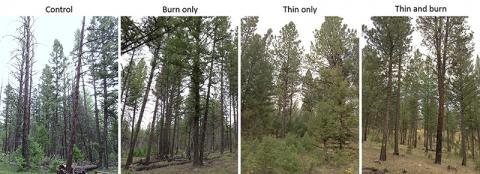Fire frequency in low-elevation coniferous forests in western North America has greatly declined since the late 1800s. In many areas, this has increased tree density and the proportion of shade- tolerant species, reduced resource availability, and increased forest susceptibility to forest insect pests and high-severity wildfire. In response, treatments are often implemented with the goal of increasing ecosystem resilience by increasing resistance to disturbance. We capitalized on an existing replicated study of fire and stand density treatments in a ponderosa pine (Pinus ponderosa)-Douglas-fir (Pseudotsuga menziesii) forest in western Montana, U.S. that experienced a naturally occurring mountain pine beetle (MPB; Dendroctonus ponderosae) outbreak five years after implementation of fuels treatments. We explored whether treatment effects on tree-level defense and stand structure affected resistance to MPB. Mortality from MPB was highest in the denser, untreated control and burn-only treatments, with approximately 50% and 39%, respectively, of ponderosa pine killed during the outbreak, compared to almost no mortality in the thin-only and thin-burn treatments. Thinning treatments, with or without fire, dramatically increased tree growth and resin ducts relative to control and burn-only treatments. Prescribed burning did not increase resin ducts, but did cause changes in resin chemistry that may have affected MPB communication and lowered attack success. While ponderosa pine remained dominant in the thin and thin-burn treatments after the outbreak, the high pine mortality in the control and burn-only treatment caused a shift in species dominance to Douglas-fir. The high Douglas-fir component in the control and burn-only treatments due to 20th century fire exclusion, coupled with high pine mortality from MPB, has likely reduced resilience of this forest beyond the ability to return to a ponderosa pine-dominated system in the absence of further fire or mechanical treatment. Our results show treatments designed to increase resistance to high-severity fire in ponderosa pine-dominated forests in the Northern Rockies can also increase resistance to MPB, even during an outbreak. This study suggests that fuel and restoration treatments in fire-dependent ponderosa pine forests that reduce tree density increase ecosystem resilience in the short term, while the reintroduction of fire is important for long-term resilience.
Lubrecht Fire-Fire Surrogate Study
Select Publications & Products
Hood, S. M., J. S. Crotteau, and C. C. Cleveland. 2024. Long-term efficacy of fuel reduction and restoration treatments in Northern Rockies dry forests. Ecological Applications:e2940.
Crotteau, J., C. Keyes, S. Hood, and A. Larson. 2020. Vegetation dynamics following compound disturbance in a dry pine forest: fuel treatment then bark-beetle outbreak. Ecological Applications 30:e02023.
Understanding Post-fire Tree Mortality: Resources & Research - This StoryMap compiles information about post-fire tree mortality based on past and current research efforts at the U.S. Forest Service Rocky Mountain Research Station, Missoula Fire Sciences Laboratory.
Crotteau, J. S., C. R. Keyes, S. M. Hood, D. L. R. Affleck, and A. Sala. 2018. Fuel dynamics after a bark beetle outbreak impacts experimental fuel treatments. Fire Ecology 14:13.
Hood, S. M., Baker, S. and Sala, A. 2016. Fortifying the Forest: Thinning and Burning Increase Resistance to a Bark Beetle Outbreak and Promote Forest Resilience. Ecological Applications 26: 1984–2000.
Hood S.M. 2016. Data supporting publication of fortifying the forest: thinning and burning increase resistance to a bark beetle outbreak and promote forest resilience. Fort Collins, CO: Forest Service Research Data Archive.
United States Senate Committee on Energy and Natural Resources. Testified at hearing on the Federal government’s role in wildfire management, the impact of fires on communities, and potential improvements to be made in fire operations. May 5, 2015
Unintended Ecological Consequences of Removing Frequent Fire. Sharon Hood. Presentation for Association for Fire Ecology 6th International Fire Ecology and Management Congress. 2015.
